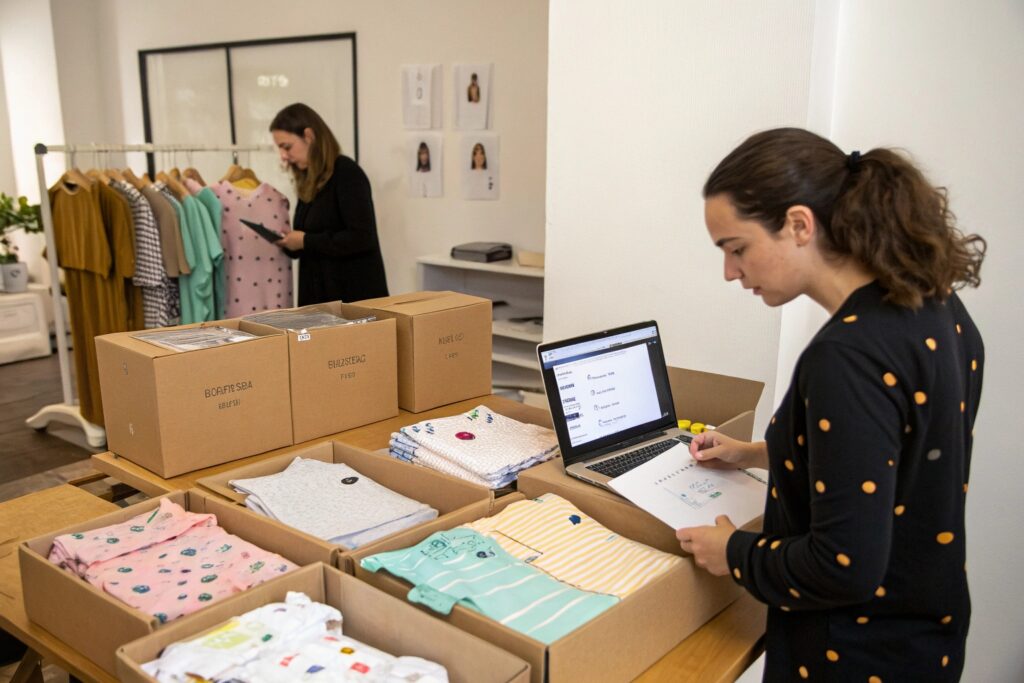Launching too much inventory too soon can kill momentum — or worse, your profit margins.
Capsule launches give brands a low-risk way to test demand, identify top-performing SKUs, and make smart decisions before scaling production.
That’s why brands — especially in kidswear — are shifting to capsule drops. In this guide, I’ll show you how capsule launches help brands understand their customers better, forecast more accurately, and optimize every product decision along the way.
How Capsule Drops Reveal Real-Time Customer Demand?
Ever poured money into a full clothing line only to realize no one wants the hero product?
Capsule drops let you gauge real-time demand by releasing a small, themed collection and tracking sales, feedback, and restock requests before committing to large-scale production.

Why are capsule drops better than pre-season guesses?
Traditional seasonal collections are based on forecasts made months in advance. You risk misreading market mood or trends. But capsule drops — often under 10 SKUs — help you react in the moment.
At Fumao Clothing, we’ve helped multiple clients launch mini-collections like a “Spring Picnic Capsule” and watched real-time sales data reveal surprises: unexpected color winners, faster-moving age groups, or a sudden interest in matching accessories.
These micro-trends are hard to spot in mass-production cycles. But when you launch a capsule, you create feedback loops that tell you exactly what your audience wants — not what you think they want.
What tools can I use to measure demand from a capsule drop?
Use a mix of:
- Sell-through rate per SKU
- Waitlist sign-ups or restock emails
- Cart abandonment feedback
- Social engagement on product posts
- Boutique reorder frequency
If you use a manufacturer like us, we can deliver weekly fulfillment updates so you track sales velocity even during short-term drops. Clients using this data often identify new bestsellers faster — and avoid waste.
Using Limited Capsules to Test Product-Market Fit
Still wondering if your product idea is worth a full production run?
Small capsule releases are ideal for testing product-market fit because they show whether your audience resonates with your brand, designs, and pricing — without locking up capital in bulk inventory.

How can I use my first capsule to validate my kidswear brand?
Here’s a typical strategy we recommend at Fumao Clothing:
- Start with 6–8 SKUs — tops, bottoms, outerwear, accessories.
- Order a micro-run — we often suggest 150–200 total units across sizes.
- Create themed content — model photos, behind-the-scenes, style guides.
- Track conversions over the first 14 days.
- Gather feedback via social polls, boutique partners, or email surveys.
One of our US clients tested a “Monochrome Toddler Capsule” and learned their audience preferred warm neutrals over greys. They also discovered 3T sizes outsold all others — insights that completely reshaped their restock.
What happens if a capsule doesn’t sell well?
It’s not failure — it’s data. Poor sales can reveal:
- Wrong audience targeting
- Unclear product value
- Seasonal mismatch
- Overpricing
Instead of dumping unsold stock, many brands repackage slow-sellers into future gift bundles or use them as influencer seeding kits. At Fumao, we also help repurpose slow SKUs by modifying trims or labels before reshipping, saving waste and cost.
What Kidswear Brands Learn from Capsule Launch Data?
Wondering how data from one small capsule can affect your entire year of planning?
Kidswear brands use capsule launch data to learn which SKUs drive repeat sales, what colorways perform best by age group, and how to adjust sizing ratios based on actual buying behavior.

What patterns emerge from analyzing capsule performance?
Let me give you some examples from our factory floor:
- A holiday capsule showed size 2Y was consistently understocked — now the brand automatically increases production in that range.
- A summer capsule with gender-neutral tones outperformed pink/blue options, prompting a rebrand toward “modern neutral” aesthetics.
- Shorts with front pockets sold out faster than plain ones — a simple detail now used across all collections.
By examining sales logs, shipping reorders, and boutique buyer notes, we help brands build future lines around actual demand, not assumptions.
What data do I need to track from every capsule drop?
At minimum, track:
| Data Type | Why It Matters |
|---|---|
| SKU sell-through | Identifies heroes and deadweight |
| Size curve analysis | Avoids overproduction of low-selling sizes |
| Color preference | Helps streamline palette for next drop |
| Geographic orders | Guides DDP logistics strategy |
| Boutique feedback | Reveals merchandising pain points or needs |
Most brands we work with at Fumao Clothing start seeing clear patterns by their second capsule drop. That’s when they refine sizing, reduce SKUs, and start scaling their winners.
Demand Forecasting Through Small-Batch Capsule Releases
Trying to plan your next quarter but overwhelmed by guesswork?
You can forecast demand more accurately by using capsule drops as testing grounds, then scaling the SKUs and sizes with proven success into larger seasonal orders.

How do small batches lower the risk of wrong forecasting?
Because you’re not guessing — you’re testing. When you launch a 200-unit capsule and it sells out in 4 days, that’s signal. If you had produced 2,000 units up front and they didn’t move, that’s deadweight.
Small batches:
- Reduce inventory cost
- Shorten production cycles
- Reveal regional demand splits
- Enable flexible scaling
And when you manufacture with us at Fumao Clothing, we can adjust your production timeline mid-season based on early results. You get rolling fulfillment options so your hits never go out of stock.
How do brands evolve their production model based on capsule data?
Here’s how a typical evolution looks:
- Test: Capsule of 6–8 SKUs, low MOQ, tracked in real-time
- Analyze: SKU sell-through, boutique reorder speed, sizing success
- Expand: Top 2–3 SKUs go into scaled production with refined colorway
- Repeat: New seasonal capsule with updated designs + data-driven sizing
This loop cuts overproduction and aligns launches with customer behavior, not just trend forecasts. You’ll save money — and earn more — by making what your audience already proved they want.
Conclusion
Capsule launches aren’t just a trend — they’re a smart, data-driven way to build better kidswear brands. With agile production partners like Fumao Clothing, you can test, learn, and scale faster than your competitors.










